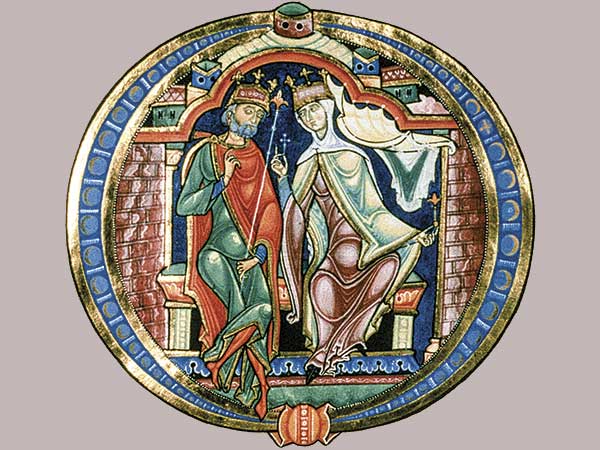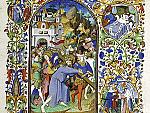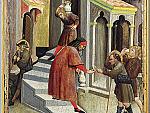Everyone a bride of Christ

[Illustration from a 12th-c. manuscript of the Song of Songs—Bridgeman Images.]
The Song of Songs, or “Canticle” as it was called, was the most written-about book of the Bible in the Middle Ages. It served as the “John 3:16” of the day. Many medieval preachers and writers used the Song of Songs to welcome people into a personal relationship with Christ. Following a tradition in use since the beginning of the church, they portrayed the bridegroom as Christ and the bride as the church. By extension, each Christian was a “bride of Christ.”
Known as “bridal mysticism,” this form of devotion invited men and women into spiritual oneness with Christ. Two Beguine writers—one from Belgium and the other from Germany—highlighted this bridal mysticism in their writing. Their prose and poetry are filled with echoes of the bride’s desire for her lover and the lover’s delight in his bride.
engulfed in the abyss
Hadewijch, one of the first authors to write in Dutch, lived in the first half of the thirteenth century in Brabant, probably around Antwerp. Chivalry was in bloom, and like the minnesingers of her day who performed courtly love poetry, Hadewijch stressed love—minne in Middle Dutch—and called her readers into a deep relationship with the Lord: “O beloved, why has not Love sufficiently overwhelmed you and engulfed you in her abyss?,” wrote Hadewijch.
Alas! When Love is so sweet, why do you not fall deep into her? And why do you not touch God deeply enough in the abyss of his Nature, which is so unfathomable? Sweet love, give yourself for Love’s sake fully to God in love.
Traveling troubadours sang of knights in shining armor who were willing to suffer anything for the love of their noble ladies. Hadewijch employed this imagery but reversed the roles for the women she led, charging them to become strong knights enduring hardship for their love of God, who is “noble love”:
He whom Love by all this proves to be noble
Becomes, thanks to the pains of love, so bold
That he proclaims: “Love, I am all yours!
I have nothing but you to revive me.
O noble Love, be all mine!”
Hadewijch knew sweet feelings would not last forever. The fading of these emotions, however, can bring Christians into a mature love for and understanding of God. So Hadewijch urged her sisters to remain steadfast in the Lord during dry times and to be “content to be deprived of sweet repose for the sake of this great totality of God!”
Around the same time, a 12-year-old German girl named Mechthild began to have wonderful encounters of God’s presence in her life. In her early twenties, she made her way to the city of Magdeburg where she joined a group of Beguines. Mechthild rose to a position of leadership among these women for a season but then seems to have been ousted by those in the community, much as Hadewijch had been.
A creative combination of autobiography, theology, poetry, and prose, Mechthild’s book Flowing Light of the Godhead depicts God’s love ever pouring out to the world and then the persons of the Godhead flowing back together in unity. By extension, wrote Mechthild, Christians are to flow out to the world in service of the sick and poor, then back to God in the solitude of prayer where they can be renewed in the love and unity of the Godhead. Above all Mechthild invited those around her into a bridal relationship with the Divine:
O Lord, if it could ever happen to me that I might gaze upon you as my heart desires and hold you in my arms, then the divine pleasures of your love would needs permeate my soul to the degree possible for people on earth. What I would be willing to suffer thereafter has never been seen by human eyes. Indeed, a thousand deaths were too little. Such, Lord, is my painful longing for you!
By Glenn E. Myers
[Christian History originally published this article in Christian History Issue #127 in 2018]
Glenn E. Myers is professor of church history and theological studies at Crown College and the author of Seeking Spiritual Intimacy: Journeying Deeper with Medieval Women of Faith as well as articles on mysticism in the Dictionary of Christian Spirituality and elsewhere.Next articles
Mystic women’s voices in the Middle Ages
Women outnumbered men in medieval mysticism.
Elizabeth Alvilda PetroffLike and unlike God
Much medieval mysticism had an unlikely source: the writings of an anonymous monk.
Edwin Woodruff TaitSeeing Christ crucified in her soul
Margery Kempe’s story gives us a window into the daily lives of many devout medieval people.
Joseph LynchPaths of influence
The spirituality of medieval mystics inspired Christians for centuries
The editorsSupport us
Christian History Institute (CHI) is a non-profit Pennsylvania corporation founded in 1982. Your donations support the continuation of this ministry
Donate







